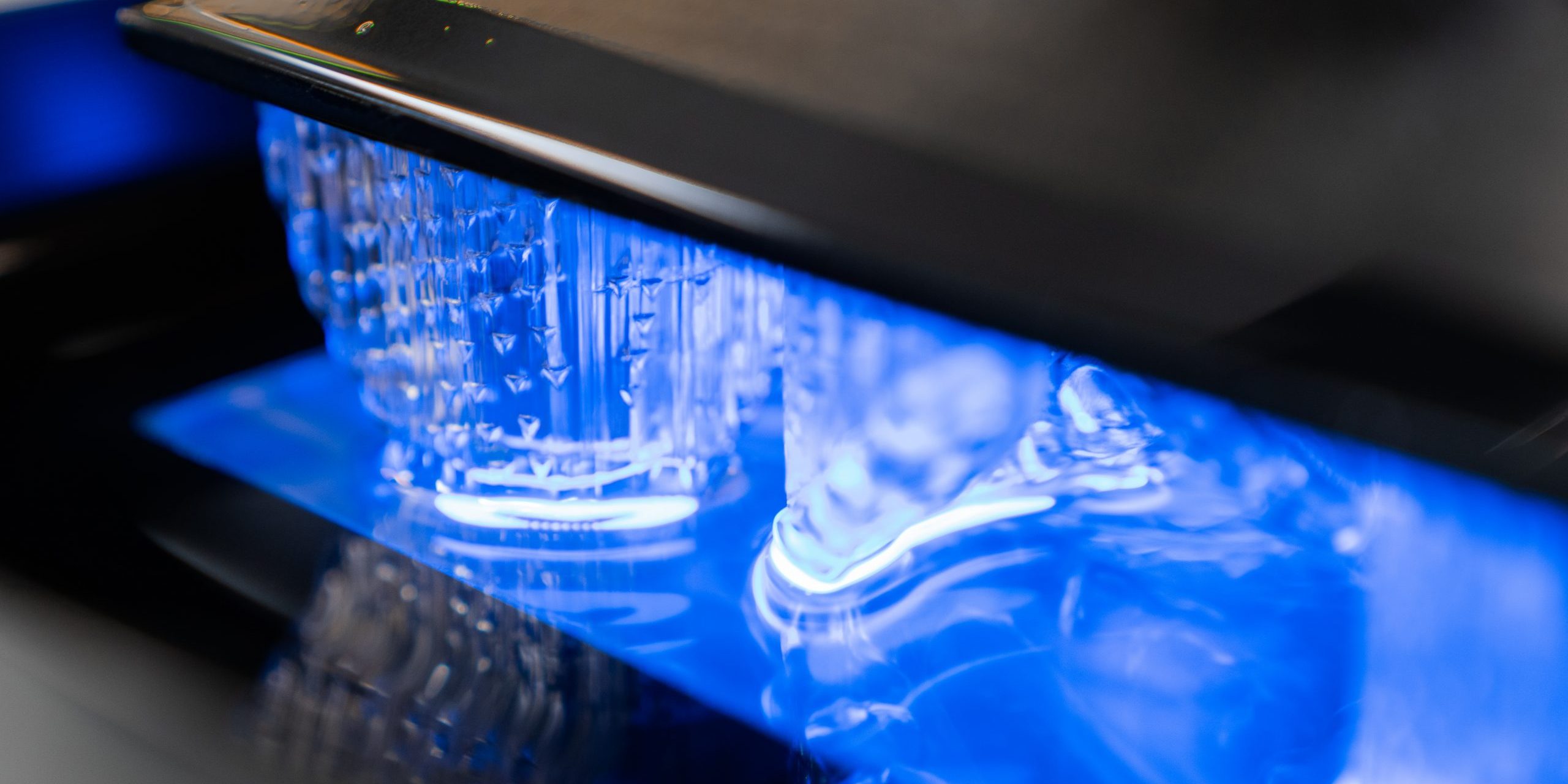Our industry has seen many advancements in technology and materials that bring efficiency to production methods and improve the level of patient care, but rarely does material development and cutting-edge hardware/software meet perfectly at the intersection of patient needs and the unique demands the industry is facing to truly be a transformative force. In this article the author will outline the benefits of Keystone’s KeySplint Soft resin for 3D printed fabrication of night guards and splints, including the production benefits and economic impact for labs, and the benefits for clinicians and patients compared to traditional processed acrylic and thermoformed prostheses. Technical material data and workflow will be covered, along with information and insight from industry executives and lab owners/operators who have transformed their businesses with this exciting new application.
Addressing a Need
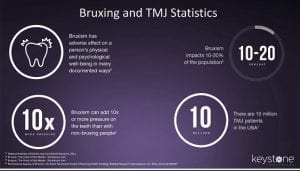
The need for night guards and splints to protect dentition from the damage caused by clenching and grinding is not new, and the benefits of these appliances are well known (Fig. 1). Ira Rosenau, President of Keystone Dental Group, shared insight about the research and development of KeySplint Soft resin. “When Keystone started its 3D printing project in 2016, we tried to assess which applications in dentistry could benefit most from a unique 3D printing resin,” said Rosenau. “A night guard resin was one of the materials we quickly focused on for a few reasons. First, there is a growing need for splint therapies in the market. There is a considerable portion of the population who suffer from bruxism and jaw disorders like TMJ, all of whom absolutely need an effective night guard to treat their condition. Second, with the explosion in popularity of zirconia restorations, and with the hardness of that material and its potential to impact the opposing dentition, protecting those teeth from potential damage with a night guard is optimal. “Third, the traditional manufacturing methods were inefficient.
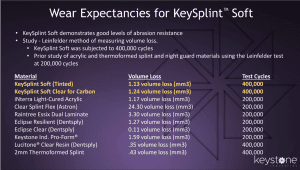
Whether by hand-making hard acrylic splints or thermoforming material over a stone model, digital design and 3D printing would be a significant advantage for labs or doctors manufacturing protective devices. Fourth, and perhaps most importantly, the existing
traditional splint materials all suffered from deficits in providing the required therapy. Most acrylic splints are very hard, and prone to fractures or breakages. KeySplint Soft was designed to address these deficits — a durable material that is strong enough to withstand the forces of bruxism, but with some added flexibility for better patient comfort and better resistance to cracks and brittle failures (Fig. 2).”
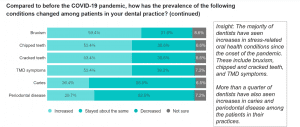
Few would argue that these are challenging times and many people are experiencing the effects of increased stress caused by the current state of world affairs. Focusing the lens on dentistry in the fourth quarter of 2020, clinicians report an increase in stress-related oral health conditions among patients including bruxism, chipped and cracked teeth, and TMD symptoms, since the onset of the pandemic (Fig. 3).
This means the need to protect dentition from stress-related clenching and grinding and subsequent demand for night guards and bite splints is high, and many labs are experiencing an increase in the number of prescriptions for them. This can be “too much of a good thing” for labs producing these appliances by traditional analog methods, however, as this spike in demand can create workflow logjams. Traditional analog fabrication of night guards and splints is time consuming and labor intensive, which can choke production bandwidth. These laborious fabrication steps can also translate to the Cost of Goods Sold (COGS) being relatively high compared to the average selling price, meaning for many labs these appliances aren’t a high profit margin product when fabricated by analog methods.
Benefits for Labs
Analog fabrication of a processed acrylic night guard requires a skilled removable technician to complete many hands-on steps at the bench (Fig. 4). 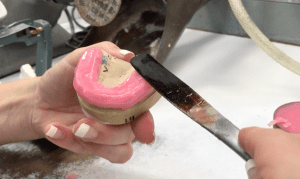 Not only is production inefficient, but there is a lot of room for inaccuracies to creep into the process, such as expansion issues with model stone and inconsistent wax thickness, that affect the fit of the final prosthesis. Robert Kreyer, CDT, the Director of Advanced Dentures and Implants at MicroDental Laboratories, compares fabricating traditional acrylic night guards versus KeySplint Soft Clear printed night guards. “Dental orthotics such as occlusal splints, occlusal devices, and night guards have been part of the removable prosthetic laboratory product line for around 50 years,” said Kreyer. “They have traditionally been made with a workflow that involves many variables during duplication of master casts, articulation, hand waxing, investing, and processing acrylic resin. This traditional or analog workflow is very labor intensive, thus increasing the cost to manufacture. In my experience, an effective digital workflow using Carbon and KeySplint Soft will save a dental laboratory 90 minutes of labor time. This includes creating a functional splint for anterior or canine guidance and static flat plane designs. KeySplint Soft is durable for functional designs while providing a very comfortable and retentive fit.”
Not only is production inefficient, but there is a lot of room for inaccuracies to creep into the process, such as expansion issues with model stone and inconsistent wax thickness, that affect the fit of the final prosthesis. Robert Kreyer, CDT, the Director of Advanced Dentures and Implants at MicroDental Laboratories, compares fabricating traditional acrylic night guards versus KeySplint Soft Clear printed night guards. “Dental orthotics such as occlusal splints, occlusal devices, and night guards have been part of the removable prosthetic laboratory product line for around 50 years,” said Kreyer. “They have traditionally been made with a workflow that involves many variables during duplication of master casts, articulation, hand waxing, investing, and processing acrylic resin. This traditional or analog workflow is very labor intensive, thus increasing the cost to manufacture. In my experience, an effective digital workflow using Carbon and KeySplint Soft will save a dental laboratory 90 minutes of labor time. This includes creating a functional splint for anterior or canine guidance and static flat plane designs. KeySplint Soft is durable for functional designs while providing a very comfortable and retentive fit.”
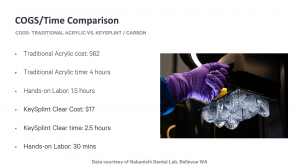
Labs that have shifted to digital printed night guard production using KeySplint Soft resin report, on average, a 65 percent reduction in the labor required to produce these appliances and also the ability to scale production predictably, something almost impossible when producing night guards by hand with traditional methods (Fig. 5). Up to ten night guards can print in around 1.5 hours on a Carbon M2 printer, faster than producing traditional acrylic splints by hand and also more efficient than digital milled splints, which take over an hour per unit to mill (Figs. 6-7). This dramatic reduction in COGS provides labs with the opportunity to position printed night guards at a lower price point while still offering the traditional hand-crafted versions on their product menu if they choose. Kurtis Helm, owner of Helm Dental Lab, said, “We used a small beta test group of clients to test the KeySplint printed night guard and received their feedback, which was overwhelmingly positive, and then added KeySplint to our product menu. This allowed us to raise the price of our traditional night guards and explain to our clients the need to do so to cover the extra labor required to produce them by hand.”
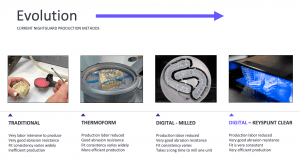
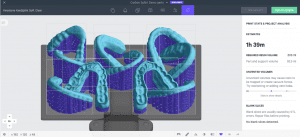
Helm reports that KeySplint Soft Clear night guard production now accounts for 80 percent of all night guards produced at Helm Dental Lab, and the lab has seen an increase in demand post-COVID. Another issue labs face when fabricating traditional acrylic splints and night guards is the shortage of experienced removable technicians in the industry, with the majority of these technicians and removable lab owners age 55 years or older and many approaching retirement. Transitioning from analog production to digital allows labs to mitigate this growing workforce shortfall by moving experienced removable technicians from production roles at the bench into roles as digital denture and night guard designers/managers, technical consultants for dental clients, and in-lab educators who share their valuable knowledge to train the next generation of digital removable technicians.
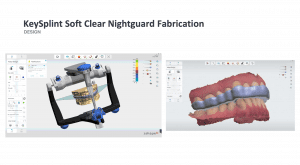
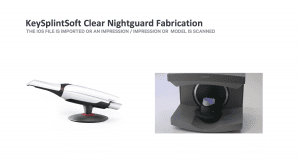
Workflow KeySplint Soft resin is available in two iterations. KeySplint Soft produces a tinted appliance available for use on many 3D printers on the market, and KeySplint Soft Clear produces a clear appliance and is exclusively validated for use on Carbon printers. Laboratory steps to produce a KeySplint Soft night guard are very straightforward. The lab can import an IOS file or use a 3D lab scanner to scan a model or a PVS impression and then design the appliance in 3Shape Splint Studio (3Shape.com) or similar splint design software (Figs. 8-9). Some labs choose to outsource the design step to providers such as Evident (Evident.com), FullContour (FullContour. com), or others either as an interim stage while transitioning and training technicians on the digital workflow or as their established protocol if they lack in-house digital splint designers. Rob Laizure, Jr., CEO of FullContour, said, “Over the past year, FullContour has seen a significant growth in CAD designed splints due to new 3D printable materials.” Labs who would like to offer night guards to their dental clients but lack the ability to print inhouse, or want to substantiate the business case before investing in 3D printing technology, can send cases to lab outsource providers such as Argen (Argen.com), Core3dcentres (Core3d.com) and Aurora Digital Technology Center (Auroradtc.com) and purchase the printed splints directly from them.
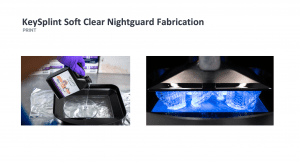
Michael Clark, SVP Domestic Sales and Marketing at Argen, said, “We have been experiencing an increase in KeySplint Soft Clear units we are producing for labs each day. Everybody at Argen is excited about the KeySplint material and the benefits these night guards bring to clinicians and patients.” Once the night guard is designed, the .stl file is sent to the printer, arranged on the build platform with supports, resin is dispensed, and the print cycle is started (Fig. 10). When the printing cycle concludes, the night guards are removed from the build platform with a spatula, and the supports are separated in a quick procedure which requires simply pulling the support material away from the splint. The splints are then placed in isopropyl alcohol (IPA) and cleaned in two consecutive three-minute wash cycles on a shaker table, and the intaglio is swabbed with IPA to ensure all remaining resin is removed before allowing the splints to air dry for 30 minutes (Figs. 11-13).
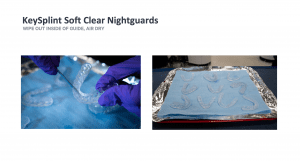
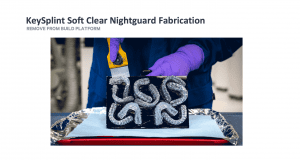
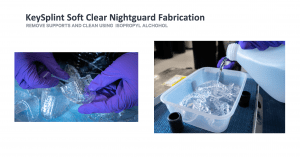
The remaining steps are a 30-minute UV cure cycle using nitrogen and then final polishing. Keystone provides a comprehensive finishing and polishing guide, which includes recommendations for buffs, wheels, and polishing paste (Figs. 14-16).

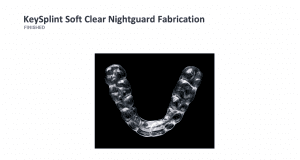 Benefits for Clinicians and Patients
Benefits for Clinicians and Patients
A major benefit for clinicians is that they do not need to change their current impression and bite record protocol to provide KeySplint Soft night guards, as labs can work from either an IOS file or a traditional PVS impression and bite registration. The ability for labs to produce these appliances more cost effectively and charge a lower retail price is also a benefit to clinicians, as is the ability to produce them quicker and deliver them to the patient faster. The fact that the digital design record can be stored by the lab for quick reproducibility if a night guard is lost or damaged without starting over from a new impression is a benefit for both patient and clinician, eliminating the need for additional appointments and saving clinical chair time. This is especially beneficial with fewer patient visits being a priority during COVID-19. Another key benefit over traditional acrylic splints is that improved fit is reported by both dentists and patients. Although it is very durable and has abrasion resistance comparable to a hard acrylic appliance, patients and dentists report that the KeySplint Soft material is more comfortable with a soft, pliable feel, which improves patient compliance. Rosenau discusses the material characteristics in relation to the reports of comfort, fit, and positive patient feedback. He said, “KeySplint Soft utilizes high purity chemistries, which are known to be less sensitizing and more biocompatible than standard chemistries. In every validated workflow, the KeySplint Soft device has very little residual monomer or impurities (well below the ISO 20795 requirements) and is tested to confirm that it is not cytotoxic. The fracture resistance of the material is between 45 and 48 joules per meter on the IZOD notched impact test, which is nearly the same impact strength of high-impact denture acrylics like Diamond D (Keystone.com). “This impact strength enhances its performance as a night guard and the expected longevity of the device. It has a very high flexural modulus and is a unique 3D printing liquid in that its modulus at room temperature changes once exposed to body temperatures (37 degrees Celsius) or warm water. The device softens a bit and becomes more flexible, thus improving the fit in the patient’s mouth. Because of this unique modulus change, the device is not painful on the teeth like some very hard splint products, and thereby, it improves patient compliance. It is more comfortable, so patients are more likely to wear the device for its intended treatment.” Night guards and splints that protect dentition from the effects of bruxism improve the lives of the patients who wear them. For clinicians and patients this process yields a next-generation appliance that can be produced quicker with a digital record for hassle-free reproducibility, and with improved fit and comfort for the user. When the benefits of a product and positive impacts are shared by all involved in a process such as this, it can truly be called a game changer.
About the Author

Jamie Stover, CDT is the Senior Manager of Dental Lab Applications at Carbon. Previously Jamie was Chief Operating Officer of Ziemek Laboratories and has been a dental laboratory technician for over 21 years. Jamie has extensive experience on all aspects of transitioning workflow from analog processes to digital both clinically and in-lab, has written over 20 articles for publication in national dental trade journals, and lectures regularly on a myriad of topics for dental professionals. In his role at Carbon Jamie is a consultant for labs and dentists on streamlining production with the digital workflow and implementing strategies for business growth and utilization of new applications. Jamie is a member of several professional organizations including: The Dental Technician Alliance of the American College of Prosthodontists, the NADL Business Management Committee, and is a trustee on the National Board for Certification for Dental Lab Technicians, among others.

